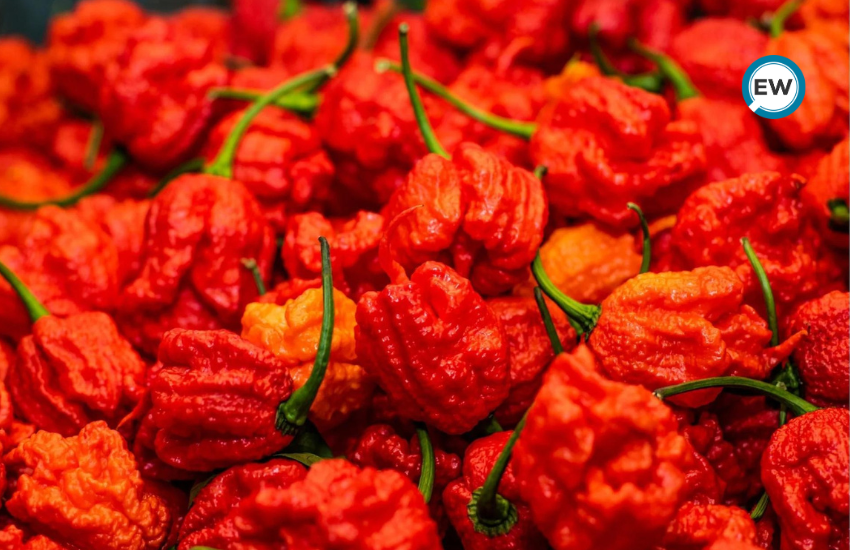The Carolina Reaper holds the prestigious title of the hottest chili pepper on the planet. This pepper, a hybrid species of Capsicum chinense, was developed by Ed Currie in South Carolina. Known for its distinctive scythe-like tail, the Reaper boasts an average heat level that can reach over 1.5 million Scoville Heat Units (SHU), with peaks at 2.2 million SHU. Its heat is not just a claim to fame but also a challenge to chili enthusiasts and a key ingredient in fiery dishes and products worldwide. In this comprehensive guide, we explore everything from its cultivation to the products that harness its scorching flavor.
What is the Carolina Reaper?
The Carolina Reaper, scientifically known as Capsicum chinense ‘Carolina Reaper’, is renowned for its extreme heat and fruity flavor, underscored by a subtle chocolate-cherry undertone. Developed by breeding a Pakastani Naga with a Red Habanero, the Reaper was intended not just for heat, but also for its unique flavor profile. This record-setting chili’s heat is measured on the Scoville scale, where it dramatically surpasses other peppers, making it a prime subject in spicy food challenges and culinary experiments. Understanding the Carolina Reaper’s heat can help appreciate why it stands atop the Scoville scale as the undisputed king of peppers.
Cultivating the Carolina Reaper Plant:
Growing the Carolina Reaper is both a rewarding and challenging endeavor. This plant prefers a warm, humid climate and requires a good amount of patience and care to thrive. Starting from seeds, which are often bought as ‘Carolina Reaper seeds’, germination can take up to 2-3 weeks under optimal conditions. The plants need regular watering but must avoid waterlogged soil. Providing them with a high-potash fertilizer can enhance their growth and fruit production. It typically takes about 90 days from transplanting for the peppers to mature, showing their bright red color and signature wrinkled appearance with a pointed tail.
Scoville Scale and the Carolina Reaper:
The Scoville scale is the definitive measurement of spiciness or heat in chili peppers, quantified by Scoville Heat Units (SHU). The Carolina Reaper’s astonishing rating ranges from 1,400,000 to 2,200,000 SHU, making it a behemoth in the world of spicy foods. This scale measures capsaicin concentration, and the Reaper’s record-setting levels are what bring both thrill and caution to all who dare to experience its heat. For perspective, the Reaper is so intense that it eclipses the common jalapeño by more than 200 times.
Carolina Reaper Products: From Sauces to Chips:
The intense heat of the Carolina Reaper has been creatively infuse into a variety of products. Catering to lovers of extreme spiciness. Among these are ‘Carolina Reaper sauces’, which range from cooking ingredients to finishing sauces. Each offering a different level of heat and flavor complexity. Additionally, the ‘Carolina Reaper chips’ and ‘Carolina Reaper chip’ provide a crunchy. Fiery snack option for those looking to test their heat tolerance. These products not only highlight the pepper’s versatility but also its ability to enhance the flavor profiles of traditional snacks and dishes.
FAQs:
How hot is the Carolina Reaper on the Scoville scale?
It ranges from 1,400,000 to 2,200,000 SHU.
Where can I buy Carolina Reaper seeds?
Carolina Reaper seeds, or ‘Carolina Reaper seeds’, can be purchase online or from specialty stores.
Is there a difference between Carolina Reaper sauce and Carolina Reaper sauces?
No significant difference, both refer to sauces made from the Carolina Reaper pepper, with varying levels of spiciness.
What are some popular Carolina Reaper products?
Popular products include Carolina Reaper sauces, chips, and even dried peppers.
How long does it take to grow a Carolina Reaper plant?
Approximately 90 days from transplanting to fruit maturity.
Can I handle Carolina Reaper peppers with my bare hands?
It’s advise to use gloves due to the extreme heat.
What is the best way to mitigate the heat after eating a Carolina Reaper?
Dairy products like milk or yogurt can help counteract the heat due to their casein content.
Can the Carolina Reaper be used in everyday cooking?
Yes, the Carolina Reaper can be used in cooking, but due to its extreme heat. It should be used sparingly and with caution to enhance dishes without overpowering them.
How does the Carolina Reaper compare to other hot peppers on the Scoville scale?
The Carolina Reaper consistently ranks at the top of the Scoville scale. Surpassing other superhot peppers such as the Ghost Pepper and Trinidad Scorpion.
Conclusion:
The Carolina Reaper is not just a pepper; it’s a culinary marvel and a testament to the limits of natural heat. It has captivated the spicy food community, not only for its title as the hottest pepper on the Scoville scale but also for its distinctive flavor and versatility in cooking. Whether you’re daring enough to try it raw. Or prefer to enjoy its heat diluted in ‘Carolina Reaper sauce’ or ‘Carolina Reaper chips’, this pepper offers an unparalleled spicy experience.
Cultivating ‘Carolina Reaper seeds’ can be a rewarding challenge for gardeners looking for something out of the ordinary. Furthermore, the array of products available. From ‘Carolina Reaper sauces’ to snacks, allows even those with a lower heat tolerance to appreciate this fiery chili. As we continue to explore the boundaries of spice. The Carolina Reaper stands as a fiery beacon for heat enthusiasts and a spicy challenge waiting to be taken.
